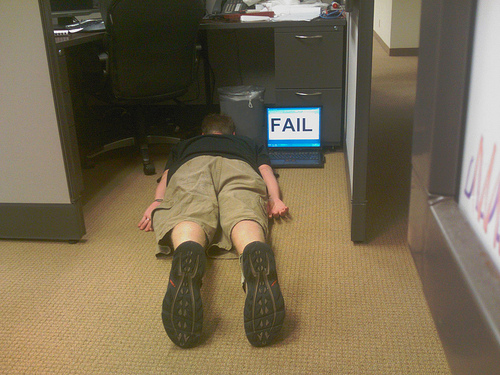I recently attended Human Resources Conference where the topic of performance appraisal came up constantly — in the keynote sessions as well as breakouts. The last speaker of the day pointed out this recurring theme: “What we’ve heard today is that everyone – employees, managers, and HR – hates the annual appraisal process as practiced at most organizations.” His call to action was to let go of this 1950’s-era management tool and replace it with something more 21st century.
“When are we going to give up trying to improve a process that everyone hates?” he asked. His observation struck me as highlighting the dominance of Management thinking in the workplace (let’s fix this problem!) versus Leadership thinking (“what really needs to happen, here?”).
Performance appraisals are not the only soul-sucking aspect of the modern workplace, of course. This month’s essay is entirely workplace-focused, asking, “What do we need to give up to create a more Positive Workplace?”
To live into more Leadership thinking and behavior, consider giving up these organizational practices that are “so last millennium!”
- The Traditional Annual Performance Appraisal. This tool was invented six generations ago by people who left the workplace before fax machines arrived. Give it up, already! Let’s replace it with a more 21st century model built on frequent smaller conversations, streaming information, goal-refinement on-the-fly, and multi-rater crowdsourcing, reflecting the way new generations operate. Let’s give up trying to fix something we all hate.
- Secrecy. In the past, one might have justified keeping information from employees for all manner of reasons, but at the core of all was that information was power, and those in charge needed to hold onto that power. Today, everyone has access to information all the time, and if they don’t get it from their managers they make up stuff — which is almost always worse than the reality. Leaders embrace Transparency, and studies show that when organizations trust their people enough to tell them the truth, the vast majority honor that trust.
- Overthinking. Life and business move too fast anymore to labor over any but the biggest decisions. The best model for change is to dive in, engage everyone fast, keep lines of communication wide open (in both directions), tweak frequently based on feedback, and keep going. Nike’s motto was never truer: just do it.
- Assuming Evil Intent. The old school model says that employees who don’t cut it are bad, lazy, or incompetent. The new schools of appreciative and strengths-based leadership recognize that no one is good at everything — so let’s identify and leverage the heck out of what people are really great at (and if someone is really a bad fit, acknowledge that as a management failure to hire well, not the fault of that person — so make a fast decision, then move forward).
- Trying to Be the Smartest Person in the Room. What got you into a management role may have been your expertise or genius at the work; but what’s going to make you a great leader is less what you know than your ability to leverage the collective genius of your team. The skills you need as a leader are more interpersonal than intellectual, so invest in your emotional competence and let go of knowing the answer. Ask others what they know.
- Expecting Perfection/Blaming Individuals. If you work in manufacturing, reducing errors to less than one in a million may be an appropriate goal. And if you’re a blood bank technician, I sure as heck hope you are perfect at typing blood, because I don’t want to die from your error. But in most work built around human interaction and change, there will be inconsistencies and mistakes. In the 1950s W. Edwards Deming wrote his 14 Leadership Principles, and in 1990 Peter Senge (The Fifth Discipline) introduced us to Systems Thinking and the concept of Learning Organizations. In both of these frameworks, mistakes are seen as issues within the system vs. the fault of individuals. Where things break down constantly, leaders need to look in the mirror and ask, “What are we missing that’s creating this situation where mistakes are frequent?” Then they leverage teams and data to constantly learn from what works/doesn’t work and continually get better.
- Avoiding Conflict. Give up making it all about you and your discomfort. If you want to be a leader, act like it: get and practice the skills you need to have tough conversations. You’ll notice that addressing conflict early and often can generate a more open culture. Plus, conflict is at the heart of creativity and innovation, so the more you embrace conflict as part of life, the more ideas will emerge in the organization.
- Management by Management. Management thinking and efficiency are vitally important. But at the heart of management is trying to produce yesterday’s successes a little faster and cheaper. Manage, yes, but through a Leadership lens, where you are ALSO asking, “What’s next?” “What do we need to do differently?” and “What do we need to let go of?”
Remember, Leadership is not about a title: Anyone can be a Leader who has the courage to let go of having the answers and instead ask the tough questions, like, “What do we need to give up that would allow us to be better?”
Image credit: slworking2 via Compfight


clicked on link for Happiness Audit (100 point checklist) but the link directed me to this article ” what do we need to give up for a happier workplace. can you send the 100 point checklist in pdf?
Stacey, try this direct link: HappinessAudit
Stacey, sorry about that. Try this direct link: HappinessAudit